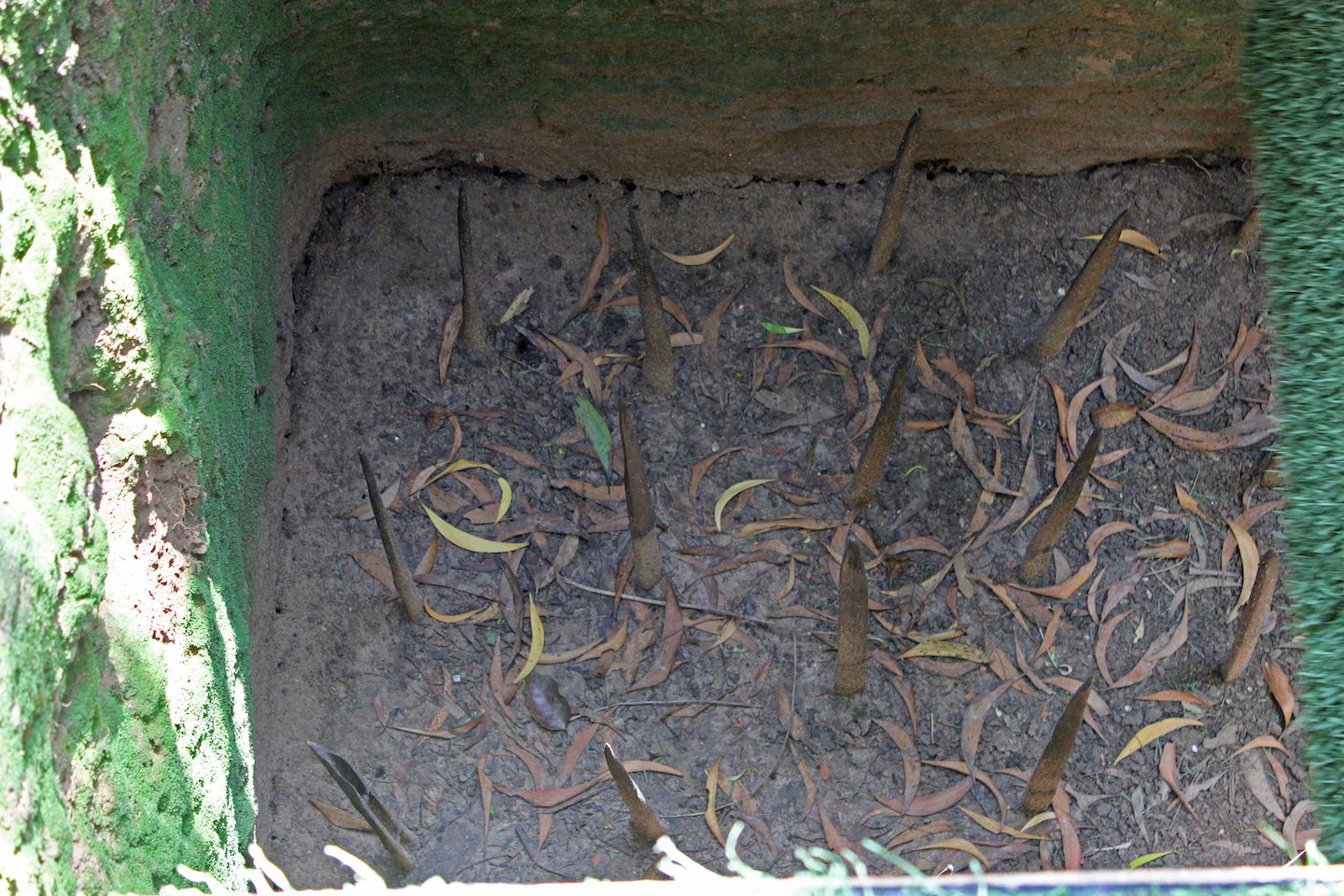From Ho Chi Minh City (Saigon), we took a half day tour to the Cu Chi tunnels, an immense network of underground tunnels that served as a base for the Viet Congs during the Vietnam War. I was pretty excited to see first hand how soldiers lived, transported supplies and controlled where and when fights would take place – all while being completely underground!
We booked our tour with the Sinh Tourist office ($5 per person), which included the roundtrip bus ride and an English speaking guide. Unlike the the city tour in Hue, this one was hassle-free.
Weapons
Upon arrival, we were first directed to the armory, which had several different weapons used during the war. From AK-47 to M-16 to M-30, the arsenal was varied and powerful. A shooting range was available where visitors could fire weapons of choice at distant targets ($1 per bullet, minimum 10 bullets). While I didn’t shoot any, the sound of other people shooting the weapons was deafening and terrifying. I could imagine the shooting sounds echoing in the forest when serious fighting was happening here.
Among the many tunnel entrances, we saw a B-52 bomb crater, which was very large. Considering that most B-52s would drop dozens of these bombs at once, the Viet Congs needed a lot of courage to wait out the bombing in tunnels until they could come out again.

Alternatively, bombs that were captured by the Viet army were then taken to the workshop, where soldiers would disassemble them and build smaller, but portable bombs (like grenades). Explosions in the workshops were common and the only real motivation to work in such a dangerous job was their hatred for the enemy.

Traps
Traps in the Cu Chi tunnel area came in various sizes and shapes. The Viet Cong laid down invisible but deadly traps all over the forest floor. They consisted of a hole in the ground filled with sharp-ended bamboo, and then another bamboo cover above that would keep the ground and leaves in place to disguise the trap.

There were several different layouts of traps, with static spears or rotating parts, each of them seeming more dangerous than the one before. I was impressed by how simple but effective the traps were. The Viet Congs may not have had fancy weapons, but they were pretty creative with what they did have.

Tunnels
One of the best stops on the tour was when our guide asked everybody to form a circle around him, as he slowly started to move the leaves and dirt on what looked like solid ground around his feet. Turns out there was a hole in the ground right there! It appeared like magic in front of our eyes. One of the many entrances to the network of tunnels, it was very tiny. I could imagine Viet Congs popping out of these holes in the ground and catching American soldiers off guard, then immediately hiding back again. It must have felt like being attacked by ghosts for the American soldiers. I volunteered to try to fit myself in.

The entire network was more than 200km of tunnels, but 100m of that has been made tourist friendly (i.e. with lights, no scorpions or bats, etc.). These had “formal” entrances with stairs built for tourists every 20m or so. This was our chance to go into the Cu Chi tunnels themselves to experience first-hand what it was like to live and fight the war underground.

Being built to fit small Asian soldiers squatting, the tunnels were incredibly small and it is extremely physically demanding for tall people to walk inside. That’s not to mention these tourist-friendly tunnels have been widened to cater to bigger and taller tourists! I can only imagine how small the original ones were.
In a full squat, with my head down, I started making my way in using my hands to guide myself. It was hot. It lacked oxygen. It was one of the most claustrophobic experiences I’ve ever had and I couldn’t wait to see the light at the end of the tunnel.

I must admit that even being in a good shape, I could only walk 20m inside the tunnels before my back and knees really started to hurt and I had to tap out. I was slightly disappointed in myself that I couldn’t walk the entire 100m available for tourists, but at the same time relieved to be out, standing up straight and breathing fresh air.
I don’t think I’ve ever learned so much by walking 20m like I did here. The tunnels were pretty well-designed, even though it didn’t start off as a plan, but rather naturally by connecting one place in a family to another underground, until the entire network formed. The tunnels could not be flooded because there are 3 levels, and the deepest level drains into the nearby river. A cross-section model of the tunnels gave us a great visual for what the system was like.

Even though the tunnels were effective against the Americans, life inside was very dangerous. The darkness, lack of oxygen, venomous animals, combined with the threat of bombs and armed enemy soldiers outside, it was by far one of the most hostile environments anyone could ever live in. I absolutely cannot imagine living in such a way and would probably not survive, let alone be able to help fight the enemy.
Cu Chi tunnels was one of our most memorable experiences in Vietnam, especially in regards to the Vietnam War. It was one thing to see photos and read explanations in a war museum, but you reach a whole other level of understanding and appreciation for what took place when you put yourself into their shoes.
For more pictures from Cu Chi tunnels, please visit the gallery!

